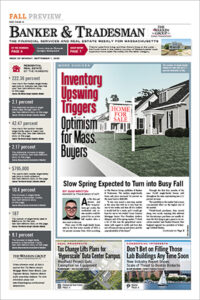
Banking trade groups say the latest plan to reform an anti-redlining law will put smaller lenders at a disadvantage. And advocacy groups think it doesn’t go far enough to help correct redlining’s racial legacy.
After a yearslong and often controversial effort by federal regulators to update the federal Community Reinvestment Act, banks could have just one year before they have to start complying with new CRA rules.
“[T]he speed at which this is expected to be turned around and implemented – 12 months – is unreasonable at best,” executives at North Adams-based MountainOne Bank said in a letter to federal regulators.
Stakeholders finished submitting feedback earlier this month on a nearly 700-page proposal aimed at modernizing regulations implementing the anti-redlining law. And both banks and community advocates have concerns about the proposed changes to regulations that had not been updated in more than 25 years.
On one hand, banking trade groups say the reforms will put medium-sized banks with only a few billion dollars in assets at a disadvantage as they try to compete with their larger brethren. On the other hand, community and housing groups say the reform doesn’t deal squarely with decades of redlining’s racial legacy.
The fraught nature of the debate shows in how long it took the three federal bank regulators to agree on joint reforms. An earlier effort failed to produce a joint proposal; instead, the Office of the Comptroller of the Currency issued its own rule in May 2020, which some critics derided as a giveaway to elements of the banking industry. The OCC’s CRA rule was eventually rescinded by the Biden administration, and the OCC, FDIC and the Federal Reserve agreed to work on a new proposal.
Some changes in the proposal include tailoring CRA evaluations and data collection to different sizes and types of bank, expanding the types of banking services considered for CRA in low- and moderate-income communities, clarifying whether an activity counts for CRA purposes and recognizing the changes in lenders’ customer bases brought on by online and mobile banking.
Activists Want More Rigor, Race Considered
While CRA is considered an anti-redlining law and part of the civil rights initiatives of the 1960s and 1970s, the law does not reference race. For many Massachusetts advocacy groups, CRA exams should include race and ethnicity when evaluating a bank’s lending activities to determine whether it serves people of color and communities of color.
The Massachusetts Affordable Housing Alliance, in a letter to regulators, pointed to Massachusetts as having “one of the worst racial homeownership gaps in the nation,” noting that more work is needed to eliminate persistent lending disparities.
“We hope regulators will recognize the long history and ongoing practice of racism in our financial systems and move decisively to explicitly include race and ethnicity (Hispanic/NonHispanic) in the regulations going forward,” MAHA said.

A long tussle over how to reform the Community Reinvestment Act has banks concerned about the new rules they’ll have to face in bank examinations.
NeighborWorks Housing Solutions, the Massachusetts Housing Partnership and the Massachusetts Association of Community Development Corporations also voiced support for the idea in their own comments.
“CRA is a Civil Rights-era law that doesn’t mention race,” Tom Callahan, executive director of the Massachusetts Community & Banking Council, told Banker & Tradesman. “We took an organizational position that race should be explicitly included in CRA as a performance measure, not just low- and moderate- income.”
This was the first time MCBC, whose membership includes banks and community organizations, had endorsed inserting race into CRA exams, Callahan said.
The National Community Reinvestment Council, whose membership includes several Massachusetts-based advocacy groups, said it wants a more rigorous exam process that does not inflate ratings, noting that most banks receive a “satisfactory” rating.
While the ABA has said it agrees the test should be rigorous, the reformed CRA now includes a “low satisfactory” rating, causing concerns among bankers that new performance standards might be unachievable.
“It seems that these heightened performance standards were proposed as an incentive for banks to increase lending to underserved communities,” Nicole Almeida, Swansea-based BayCoast Bank’s senior vice president, chief diversity officer and CRA officer, said in a letter. “[H]owever, the proposed performance benchmarks for the Retail Lending Test may be unachievable for a significant amount of banks.”
Ben Craigie, Massachusetts Bankers Association vice president of government affairs, told Banker & Tradesman that a “low satisfactory” rating could risk a bank’s reputation. The trade group recommended regulators eliminate the “low satisfactory” rating and mirror instead Massachusetts’ state-level CRA system, which separates midlevel performance into “satisfactory” and “high satisfactory” ratings.
Bankers Say Medium-Sized Lenders Hurt
Four tests have been created in the proposed rules – retail lending test, retail services and products test, community development financing test, and community development services test. And new asset thresholds will determine the tests applicable at each bank.
Small banks with assets under $600 million could choose to keep the current CRA framework; intermediate banks with assets under $2 billion would be subject to the retail lending test and either keep the current framework for community development or opt into the new community development financing test.
Large banks would be subject to all four tests.
For community organizations, increasing the asset thresholds for determining the testing requirements would reduce the required activities these banks would need for CRA purposes.
In a letter to regulators, Joseph Kriesberg, president of MACDC, pointed to NCRC estimates that over $1 billion in community development financing could be lost from adjusting these thresholds.
“If that estimate proves to be anywhere close to accurate, it would be a significant failure for the regulating agencies,” Kriesberg said.
But for banking lobby groups, these increases did not go far enough.

Diane McLaughlin
The American Bankers Association said the threshold for intermediate banks should be capped at $3.3 billion. The Massachusetts Bankers Association signed the ABA’s letter, but the state trade group submitted a separate letter calling for a $750 million cap for small banks and $3 billion for intermediate banks.
For banking groups, the complexity of the new retail lending test drives recommendations for higher asset thresholds.
Concerns about the retail lending test include the fairness of comparing banks with a few billion in assets to larger banks. Patrick Murray, president and CEO of Bristol County Savings Bank, said in a comment letter that having a test heavily focused on lending could make CRA more of a competition between banks for the same population of loans.
“If we strive to help our communities, why should we be penalized for making fewer loans than a much larger institution?” Murray said. “While we recognize that creating complete equity among all the institutions regulated under CRA is difficult at best, this level of disparity is very concerning for community banks like us.”
Rapid Rollout a Worry
Banks also want more time to implement the rules.
“When we talk about a delayed implementation process, it’s not to get out of complying with regulations or punting things,” said Craigie, with Mass. Bankers. “It’s because we want to make sure that the banks have adequate resources and an adequate amount of time.”
Craigie pointed out that a two-year implementation would line up with past regulatory changes, including the Truth in Lending Act and the Real Estate Settlement Procedures Act.
The ABA said the bank regulators’ aggressive time frames have suggested that they want to implement the rule before a possible change in the administration in 2025.
“Regulators, banks, consumer and community advocates, and other stakeholders have come too far and worked too hard to rush the final stage of this important work,” the ABA said.





